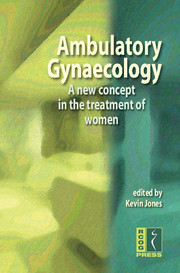Book contents
- Frontmatter
- Contents
- ABOUT THE AUTHORS
- ABBREVIATIONS
- PREFACE
- Chapter 1 Introduction
- Chapter 2 Anaesthesia and analgesia for outpatient gynaecology
- Chapter 3 Colposcopy services
- Chapter 4 Abnormal uterine bleeding
- Chapter 5 Endometrial ablation
- Chapter 6 Urogynaecology: urinary incontinence and genital prolapse
- Chapter 7 Infertility
- Chapter 8 Early pregnancy units and emergency gynaecological services
- Chapter 9 Pelvic utrasound and interventional radiology
- Index
Chapter 6 - Urogynaecology: urinary incontinence and genital prolapse
Published online by Cambridge University Press: 05 June 2014
- Frontmatter
- Contents
- ABOUT THE AUTHORS
- ABBREVIATIONS
- PREFACE
- Chapter 1 Introduction
- Chapter 2 Anaesthesia and analgesia for outpatient gynaecology
- Chapter 3 Colposcopy services
- Chapter 4 Abnormal uterine bleeding
- Chapter 5 Endometrial ablation
- Chapter 6 Urogynaecology: urinary incontinence and genital prolapse
- Chapter 7 Infertility
- Chapter 8 Early pregnancy units and emergency gynaecological services
- Chapter 9 Pelvic utrasound and interventional radiology
- Index
Summary
Introduction
The assessment and investigation of the gynaecological patient are rapidly moving away from the operating theatre and ward environment and into the outpatient department. This move has been fuelled by the demands of the patient and the clinician for a rapid, accurate diagnosis, with the minimum of investigations and invasive procedures, as well as by the economic constraints of inpatient admission.
Urinary incontinence and genital prolapse are common and debilitating conditions. Estimates of their prevalence vary considerably according to the different populations studied and the various definitions used. Whichever estimates are used, however, urinary incontinence and genital prolapse are undoubtedly common in apparently healthy women. Urinary incontinence may be defined as ‘the complaint of any involuntary leakage of urine’. Not everyone with incontinence is sufficiently bothered by the symptoms to want help. Furthermore, there is reluctance to seek help and only about one-third of regularly incontinent women discuss their problem with a nurse or general practitioner.
In this chapter, we first describe what investigations and management can be undertaken at the primary care level for women with symptoms of urinary incontinence and genital prolapse, and we suggest referral guidelines that are vital for the effective use of secondary care resources. We then describe what can reasonably be covered in a single visit to a specialist urogynaecology clinic, the so-called the ‘one-stop urogynaecology clinic’.
- Type
- Chapter
- Information
- Ambulatory GynaecologyA New Concept in the Treatment of Women, pp. 70 - 81Publisher: Cambridge University PressPrint publication year: 2008



